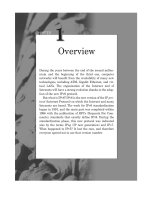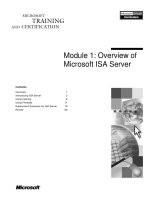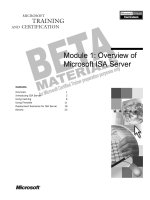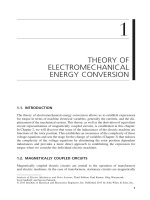Lecture Database management systems Chapter 1 Overview of database management system
Bạn đang xem bản rút gọn của tài liệu. Xem và tải ngay bản đầy đủ của tài liệu tại đây (938.32 KB, 24 trang )
Chapter 1
Overview of Database
Management System
Objectives
Overview of DBMS
An Example
Characteristics of the Database
DBMS vs. File-based system
Advantages of using the DBMS approach
Data and Information
Data:
◦ Raw facts that constitute building block of
information.
◦ The heart of the DBMS.
All the data will not convey useful
information.
processed
Data
Information
Data
Collection of
information
metadata
Database
A database:
◦ A collection of data that are related in a
meaningful way, which can be accessed in
different logical orders.
The main features of the data in the
database:
◦ Well organized (structured)
◦ Related
◦ Accessible in different orders
Database example
Book airline ticket
Register a new course in university
Buy book in the bookstore
Library management
…
Database
Simplified
database view
Database Management System
DBMS
◦ A general purpose software package designed
to store and manage database.
DBMS is helpful in maintaining and
utilizing a database.
Database Management System
Capabilities of database management system
Data dictionary
Data dictionary or “system catalog”
◦ A centralized store of information about the
database.
◦ Contain information about the tables, the
fields the tables contain, data types, primary
keys, indexes, the joins which have been
established between those tables, referential
integrity, cascades update, cascade delete, etc.
Metadata
Metadata:
◦ the information (data) about the data in a
database.
◦ Available for query and manipulation, just as
other data in the database
Database Models
A collection of tools for describing the
database (include data, relationships,
sematics, constraints) at a level of abstraction
Levels of abstraction:
◦ Conceptual Data Model:
a high level description useful for requirements
understanding.
◦ Representational Data Model
describing the logical representation of data without
giving details of physical representation.
◦ Physical Data Model
description giving details about record formats,file
structures etc.
Objectives
Overview of DBMS
An Example
Characteristics of the Database
DBMS vs. File-based system
Advantages of using the DBMS approach
The University Database
The University Database Context: maintaining
information concerning students, courses, and
grades in a university environment.
STUDENT file stores data on each student
COURSE file stores data on each course
SECTION file stores data on each section of
each course
GRADE_REPORT file stores the grades that
students receive
PREREQUISITE file stores the prerequisites
Objectives
Overview of DBMS
An Example
Characteristics of the Database
Advantages of using the DBMS approach
Database Management System
Objectives of DBMS:
◦ Data availability: users can easily access the
data.
◦ Data integrity: the data available in the
database is a reliable data
◦ Data security: only authorized users can
access the data. Data security can be enforced
by passwords.
◦ Data Independence: DBMS allows the user to
store, update, and retrieve data in an efficient
manner.
File-Based System vs. DBMS
Duplication of data: same data being stored
more than once.
Data dependence: the application program
depends on the data
Incompatible file formats: the structure of
the file depends on the application
programming language.
Separation, and isolation of data: must
synchronize the processing of two files to
ensure that the correct data are extracted. If
data has to be retrieved from more than two
files difficult to access.
The levels of data abstraction
The levels of data abstraction
Physical level or internal level:
◦ the physical storage of the information
◦ complex low-level data structures in detail
Logical level or conceptual level:
◦ describes what data are stored in the database and
what relationships exist among those data.
◦ the entire database in terms of a small number of
simple structures.
View level or external level:
◦ the highest level of abstraction. It is the view that the
individual user of the database has.
◦ There can be many view level abstractions of the same
data.
People Interacting with Database
Database Administrator
People interacting
with database
Database Designer
Database User
Application
Programmer
End-user
Objectives
Overview of DBMS
An Example
Characteristics of the Database
Advantages of using the DBMS approach
Advantages of DBMS
Centralized data management:
◦ Reducing redundancies
◦ Making data management more efficient
◦ Providing persistent storage of program objects
and data structures
◦ Providing Backup and Recovery facilities
Data Independence:
◦ programs are isolated from changes in the way
the data are structured and stored.
◦ DBMS provides the interface between the
application programs and the data.
Advantages of DBMS
Data consistency:
◦ Enforcing Integrity Constraints so as to
maintain the consistency of database
Data Security
◦ Restricting unauthorized access
Providing multiple user interfaces
Review
What is Database? Give an example.
Define – DBMS
What are the advantages of using DBMS?
Summary
The main objective of database
management system is to store and
manipulate the data in an efficient manner.
A database is an organized collection of
related data.
All the data will not give useful
information. Only processed data gives
useful information, which helps an
organization to take important decisions.









